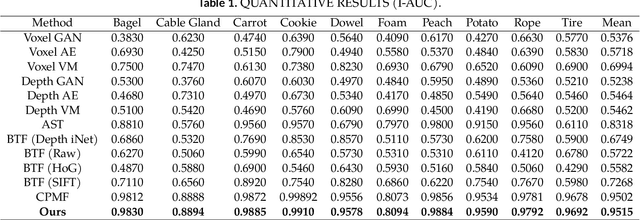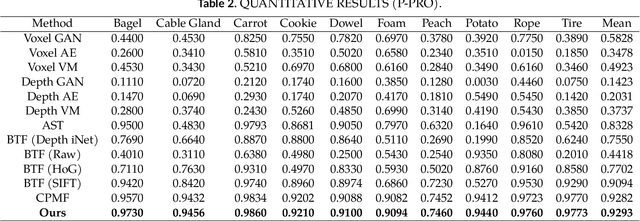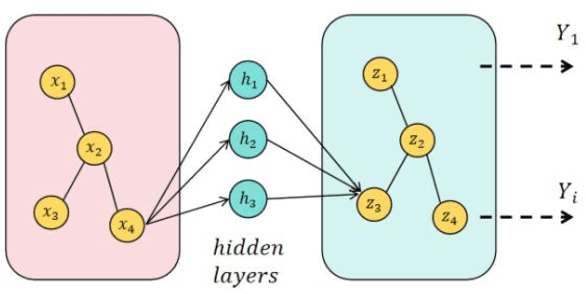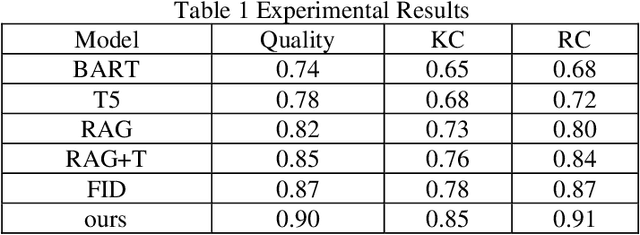Zhenhong Zhang
Optimized CNNs for Rapid 3D Point Cloud Object Recognition
Dec 03, 2024



Abstract:This study introduces a method for efficiently detecting objects within 3D point clouds using convolutional neural networks (CNNs). Our approach adopts a unique feature-centric voting mechanism to construct convolutional layers that capitalize on the typical sparsity observed in input data. We explore the trade-off between accuracy and speed across diverse network architectures and advocate for integrating an $\mathcal{L}_1$ penalty on filter activations to augment sparsity within intermediate layers. This research pioneers the proposal of sparse convolutional layers combined with $\mathcal{L}_1$ regularization to effectively handle large-scale 3D data processing. Our method's efficacy is demonstrated on the MVTec 3D-AD object detection benchmark. The Vote3Deep models, with just three layers, outperform the previous state-of-the-art in both laser-only approaches and combined laser-vision methods. Additionally, they maintain competitive processing speeds. This underscores our approach's capability to substantially enhance detection performance while ensuring computational efficiency suitable for real-time applications.
A Combined Encoder and Transformer Approach for Coherent and High-Quality Text Generation
Nov 19, 2024


Abstract:This research introduces a novel text generation model that combines BERT's semantic interpretation strengths with GPT-4's generative capabilities, establishing a high standard in generating coherent, contextually accurate language. Through the combined architecture, the model enhances semantic depth and maintains smooth, human-like text flow, overcoming limitations seen in prior models. Experimental benchmarks reveal that BERT-GPT-4 surpasses traditional models, including GPT-3, T5, BART, Transformer-XL, and CTRL, in key metrics like Perplexity and BLEU, showcasing its superior natural language generation performance. By fully utilizing contextual information, this hybrid model generates text that is not only logically coherent but also aligns closely with human language patterns, providing an advanced solution for text generation tasks. This research highlights the potential of integrating semantic understanding with advanced generative models, contributing new insights for NLP, and setting a foundation for broader applications of large-scale generative architectures in areas such as automated writing, question-answer systems, and adaptive conversational agents.
Advanced RAG Models with Graph Structures: Optimizing Complex Knowledge Reasoning and Text Generation
Nov 06, 2024


Abstract:This study aims to optimize the existing retrieval-augmented generation model (RAG) by introducing a graph structure to improve the performance of the model in dealing with complex knowledge reasoning tasks. The traditional RAG model has the problem of insufficient processing efficiency when facing complex graph structure information (such as knowledge graphs, hierarchical relationships, etc.), which affects the quality and consistency of the generated results. This study proposes a scheme to process graph structure data by combining graph neural network (GNN), so that the model can capture the complex relationship between entities, thereby improving the knowledge consistency and reasoning ability of the generated text. The experiment used the Natural Questions (NQ) dataset and compared it with multiple existing generation models. The results show that the graph-based RAG model proposed in this paper is superior to the traditional generation model in terms of quality, knowledge consistency, and reasoning ability, especially when dealing with tasks that require multi-dimensional reasoning. Through the combination of the enhancement of the retrieval module and the graph neural network, the model in this study can better handle complex knowledge background information and has broad potential value in multiple practical application scenarios.
TRIZ Method for Urban Building Energy Optimization: GWO-SARIMA-LSTM Forecasting model
Oct 20, 2024



Abstract:With the advancement of global climate change and sustainable development goals, urban building energy consumption optimization and carbon emission reduction have become the focus of research. Traditional energy consumption prediction methods often lack accuracy and adaptability due to their inability to fully consider complex energy consumption patterns, especially in dealing with seasonal fluctuations and dynamic changes. This study proposes a hybrid deep learning model that combines TRIZ innovation theory with GWO, SARIMA and LSTM to improve the accuracy of building energy consumption prediction. TRIZ plays a key role in model design, providing innovative solutions to achieve an effective balance between energy efficiency, cost and comfort by systematically analyzing the contradictions in energy consumption optimization. GWO is used to optimize the parameters of the model to ensure that the model maintains high accuracy under different conditions. The SARIMA model focuses on capturing seasonal trends in the data, while the LSTM model handles short-term and long-term dependencies in the data, further improving the accuracy of the prediction. The main contribution of this research is the development of a robust model that leverages the strengths of TRIZ and advanced deep learning techniques, improving the accuracy of energy consumption predictions. Our experiments demonstrate a significant 15% reduction in prediction error compared to existing models. This innovative approach not only enhances urban energy management but also provides a new framework for optimizing energy use and reducing carbon emissions, contributing to sustainable development.
Automated Genre-Aware Article Scoring and Feedback Using Large Language Models
Oct 18, 2024



Abstract:This paper focuses on the development of an advanced intelligent article scoring system that not only assesses the overall quality of written work but also offers detailed feature-based scoring tailored to various article genres. By integrating the pre-trained BERT model with the large language model Chat-GPT, the system gains a deep understanding of both the content and structure of the text, enabling it to provide a thorough evaluation along with targeted suggestions for improvement. Experimental results demonstrate that this system outperforms traditional scoring methods across multiple public datasets, particularly in feature-based assessments, offering a more accurate reflection of the quality of different article types. Moreover, the system generates personalized feedback to assist users in enhancing their writing skills, underscoring the potential and practical value of automated scoring technologies in educational contexts.
Contrastive Learning for Knowledge-Based Question Generation in Large Language Models
Sep 21, 2024Abstract:With the rapid development of artificial intelligence technology, especially the increasingly widespread application of question-and-answer systems, high-quality question generation has become a key component in supporting the development of these systems. This article focuses on knowledge-based question generation technology, which aims to enable computers to simulate the human questioning process based on understanding specific texts or knowledge bases. In light of the issues of hallucination and knowledge gaps present in large-scale language models when applied to knowledge-intensive tasks, this paper proposes an enhanced question generation method that incorporates contrastive learning. This method utilizes multiple models to jointly mine domain knowledge and uses contrastive learning to guide the model in reducing noise and hallucinations in generation. Experimental results show that by designing prompts containing contrasting examples, the model's performance in question generation improves considerably, particularly when contrasting instructions and examples are used simultaneously, leading to the highest quality of generated questions and improved accuracy. These results demonstrate that the method proposed in this study, which combines contrasting context and chain-of-thought prompts, can effectively improve both the quality and the practicality of question generation.
 Add to Chrome
Add to Chrome Add to Firefox
Add to Firefox Add to Edge
Add to Edge